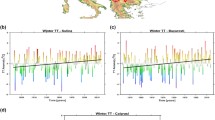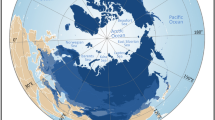Abstract
Historical dates of ice-affected flows for 16 rural, unregulated rivers in northern New England, USA were analyzed. The total annual days of ice-affected flow decreased significantly (p < 0.1) over the 20th century at 12 of the 16 rivers. On average, for the nine longest-record rivers, the total annual days of ice-affected flow decreased by 20 days from 1936 to 2000, with most of the decrease occurring from the 1960s to 2000. Four of the 16 rivers had significantly later first dates of ice-affected flow in the fall. Twelve of the 16 rivers had significantly earlier last dates of ice-affected flow in the spring. On average, the last dates became earlier by 11 days from 1936 to 2000 with most of the change occurring from the 1960s to 2000. The total annual days of ice-affected flow were significantly correlated with November through April air temperatures (r = −0.70) and with November through April precipitation (r = −0.52). The last spring dates were significantly correlated with March through April air temperatures (r = −0.73) and with January through April precipitation (r = −0.37). March mean river flows increased significantly at 13 of the 16 rivers in this study.
Similar content being viewed by others
References
Ashton, G. D.: 1986, River and Lake Ice Engineering, Water Resource Publications, Littleton, Colorado.
Baron, W. R. and Smith, D. C.: 1996, ‘Growing season parameter reconstruction for New England using killing frost records, 1697–1947,’ Maine Agricultural Experiment Station Bulletin 846, University of Maine, Orono, Maine.
Beltaos, S.: 1995, River Ice Jams, Water Resource Publications, Littleton, Colorado.
Bradbury, J. A., Keim, B. D. and Wake, C. P.: 2002a, ‘U.S. East Coast trough indices at 500 hPa and New England winter climate,’ J. Climate 15, 3509–3517.
Bradbury, J. A., Dingman, S. L. and Keim, B. D.: 2002b, ‘New England drought and relations with large scale atmospheric circulation patterns,’ J. Am. Water Resour. As. 38, 1287–1299.
Burn, D. H. and Hag Elnur, M. A.: 2002, ‘Detection of hydrologic trends and variability,’ J. Hydrol. 255, 107–122.
Cember, R. P. and Wilks, D. S.: 1993, ‘Climatological atlas of snowfall and snow depth for the northeastern United States and southeastern Canada,’ Northeast Regional Climate Center Publication No. RR 93–1, Ithaca, New York.
Cleveland, W. S. and Devlin, S. J.: 1988, ‘Locally-weighted regression: an approach to regression analysis by local fitting,’ J. Am. Stat. Assoc. 83, 596–610.
Cooter, E. J. and Leduc, S. K.: 1995, ‘Recent frost date trends in the north-eastern USA,’ Int. J. Climatol. 15, 65–75.
Dettinger, M. D. and Cayan, D. R.: 1995, ‘Large-scale atmospheric forcing of recent trends toward early snowmelt runoff in California,’ J. Climate 8, 606–623.
Douglas, E. M., Vogel, R. M., and Kroll, C. N.: 2000, ‘Trends in floods and low flows in the United States: Impact of spatial correlation,’ J. Hydrol. 240, 90–105.
Dudley, R. W. and Hodgkins, G. A.: 2002, ‘Trends in streamflow, river ice, and snowpack for coastal river basins in Maine during the 20th century,’ U.S. Geological Survey Water-Resources Investigations Report 02–4245.
Fennessey, N. and Kirshen, P.: 1994, ‘Evaporation and evapotranspiration under climate change in New England,’ J. Water Res. Plan.-ASCE 120, 48–69.
Ginzburg, B. M., Polyakova, K. N. and Soldatova, I. I.: 1992, ‘Secular changes in dates of ice formation on rivers and their relationship with climate change,’ Soviet Meteorol. Hydrol. 12, 57–64.
Grover, N. G.: 1937, ‘The floods of March 1936, Part 1. New England rivers,’ U.S. Geological Survey Water-Supply Paper 798.
Hartley, S. and Dingman, S. L.: 1993, ‘Effects of climatic variability on winter-spring runoff in New England basins,’ Phys. Geogr. 14, 379–393.
Helsel, D. R. and Hirsch, R. M.: 1992, Statistical Methods in Water Resources, Elsevier, Amsterdam.
Hodgkins, G. A., Dudley, R. W. and Huntington, T. G.: 2003a, ‘Changes in the timing of high river flows in New England in the 20th Century,’ J. Hydrol. 278, 244–252.
Hodgkins, G. A., Caldwell, J. M. and Dudley, R. W.: 2003b, ‘Historical dates of ice-affected flows for 18 rivers in New England,’ U.S. Geological Survey Open-File Report 03–245.
Hodgkins, G. A., James, I. C., and Huntington, T. G.: 2002, ‘Historical changes in lake ice-out dates as indicators of climate change in New England, 1850–2000,’ Int. J. Climatol. 22, 1819– 1827.
Hoyt, W. G.: 1913, ‘The effects of ice on stream flow,’ U.S. Geological Survey Water-Supply Paper 337.
Huntington, T. G.: 2003, ‘Climate warming could reduce runoff significantly in New England, USA,’ Agr. Forest Meteorol. 117, 193–201.
Huntington, T. G., Hodgkins, G. A. and Dudley, R. W.: 2003, ‘Historical trend in river ice thickness and coherence in hydroclimatological trends in Maine,’ Clim. Change 61: 217–236.
Irland, L. C.: 1998, ‘Maine’s forest area, 1600–1995: Review of available estimates,’ Maine Agricultural and Forest Experiment Station Miscellaneous Publication 736, University of Maine, Orono, Maine.
Karl, T. R., Diaz H. and Kukla G.: 1988, ‘Urbanization: Its detection in the climate record,’ J. Climate 1, 1099–1123.
Karl, T. R. and Williams, C. N.: 1987, ‘An approach to adjusting climatological time series for discontinuous inhomogeneities,’ J. Clim. Appl. Meteorol. 26, 1744–1763.
Karl, T. R., Williams, C. N., Jr., Quinlan, F. T. and Boden, T. A.: 1990, ‘United States historical climatology network (HCN) serial temperature and precipitation data,’ Publication No. 3404. Carbon Dioxide Information and Analysis Center, Oak Ridge National Laboratory, Oak Ridge, Tennessee.
Karl, T. R., Williams, C. N., Jr. and Young, P. J.: 1986, ‘A model to estimate the time of observation bias associated with monthly mean maximum, minimum, and mean temperatures for the United States,’ J. Clim. Appl. Meteorol. 25, 145–160.
Keim, B. D., Wilson, A. M., Wake, C. P. and Huntington, T. G.: 2003, ‘Are there spurious trends in the United States Climate Division database?,’ Geophys. Res. Lett. 30(7), 1404, doi: 10.1029/2002GL016295.
Kerr, D. J., Shen, H. T. and Daly, S. F.: 2002, ‘Evolution and hydraulic resistance of anchor ice on gravel bed,’ Cold. Reg. Sci. Technol. 35, 101–114.
Kuusisto, E. and Elo, A. R.: 2000, ‘Lake and river ice variables as climate indicators in northern Europe,’ Verh. Int. Verein. Limnol. 27, 2761–2764.
Lettenmaier, D. P., Wood, E. F. and Wallis, J. R.: 1994, ‘Hydro-climatological trends in the continental United States, 1948–88,’ J. Climate 7, 586–607.
Lindstrom, G. and Bergstrom S.: 2004, ‘Runoff trends in Sweden 1807–2000,’ Hydrol. Sci. J. 49, 69–82.
Livezey, R. E. and Chen, W. Y.: 1983, ‘Statistical field significance and its determination by Monte Carlo techniques,’ Mon. Weather Rev. 111, 46–59.
Magnuson, J. J., Robertson, D. M., Benson, B. J., Wynne, R. H., Livingstone, D. M., Arai, T., Assel, R. A., Barry, R. G., Card, V., Kuusisto, E., Granin, N. G., Prowse, T. D., Stewart, K. M. and Vuglinski, V. S.: 2000, ‘Historical trends in lake and river ice cover in the Northern Hemisphere,’ Science 289, 1743–1746.
Moore, M., Pace, M., Mather, J., Murdoch, P., Howarth, R., Folt, C., Chen, C., Hemond, H., Flebbe, P. and Driscoll, C.: 1997, ‘Potential effects of climate change on freshwater ecosystems of the New England/Mid-Atlantic region,’ Hydrol. Process. 11, 925–947.
Power, G., Cunjak, R., Flannagan, J., and Katopodis, C.: 1993, ‘Biological effects of river ice,’ in Prowse, T. D. and Gridley, N. C. (eds.), Environmental Aspects of River Ice, Environment Canada.
Prowse, T. D.: 1994, ‘Environmental significance of ice to streamflow in cold regions,’ Freshwater Biol. 32, 241–259.
Prowse, T. D. and Beltaos, S.: 2002, ‘Climatic control of river-ice hydrology: A review,’ Hydrol. Process. 16, 805–822.
Quayle, R. G., Easterling, D. R., Karl, T. R. and Hughes, P. Y.: 1991, ‘Effects of recent thermometer changes in the cooperative station network,’ Bull. Am. Meteorol. Soc. 72, 1718–1723.
Rantz, S. E., et al.: 1982, ‘Measurement and computation of streamflow,’ U.S. Geological Survey Water-Supply Paper 2175.
Schwartz, M. D. and Reiter, B. E.: 2000, ‘Changes in North American spring,’ Int. J. Climatol. 20, 929–932.
Scrimgeour, G. J., Prowse, T. D., Culp, J. M. and Chambers, P. A.: 1994, ‘Ecological effects of river-ice breakup: A review and perspective,’ Freshwater Biol. 32, 261–275.
Smith, L. C.: 2000, ‘Trends in Russian Arctic river-ice formation and breakup, 1917 to 1994,’ Phys. Geogr. 21, 46–56.
Soldatova, I. I.: 1993, ‘Secular variations in river breakup dates and their relationship with climate variations,’ Soviet Meteorol. Hydrol. 9, 89–96. [In Russian]
Sparks, T. H. and Menzel, A.: 2002, ‘Observed changes in seasons: an overview,’ Int. J. Climatol. 22, 1715–1725.
Valiela, I. and Bowen, J. L.: 2003, ‘Shifts in winter distribution in birds: Effects of global warming and local habitat change,’ Ambio 32, 476–480.
Wettstein, J. J. and Mearns, L. O.: 2002, ‘The influence of the North Atlantic-Arctic Oscillation on mean, variance, and extremes of temperature in the northeastern United States and Canada,’ J. Climate 24, 3586–3600.
Wing, L.: 1943, ‘Freezing and thawing dates of lakes and rivers as phenological indicators,’ Mon. Weather Rev. 71, 149–158.
Zhang, X., Harvey, K. D., Hogg, W. D. and Yuzyk, T. R.: 2001, ‘Trends in Canadian streamflow,’ Water Resour. Res. 37, 987–998.
Author information
Authors and Affiliations
Corresponding author
Additional information
The U.S. Government right to retain a non-exclusive royalty-free license in and to any copyright is acknowledged.
Rights and permissions
About this article
Cite this article
Hodgkins, G.A., Dudley, R.W. & Huntington, T.G. Changes in the Number and Timing of Days of Ice-Affected Flow on Northern New England Rivers, 1930–2000. Climatic Change 71, 319–340 (2005). https://doi.org/10.1007/s10584-005-5926-z
Received:
Revised:
Issue Date:
DOI: https://doi.org/10.1007/s10584-005-5926-z




